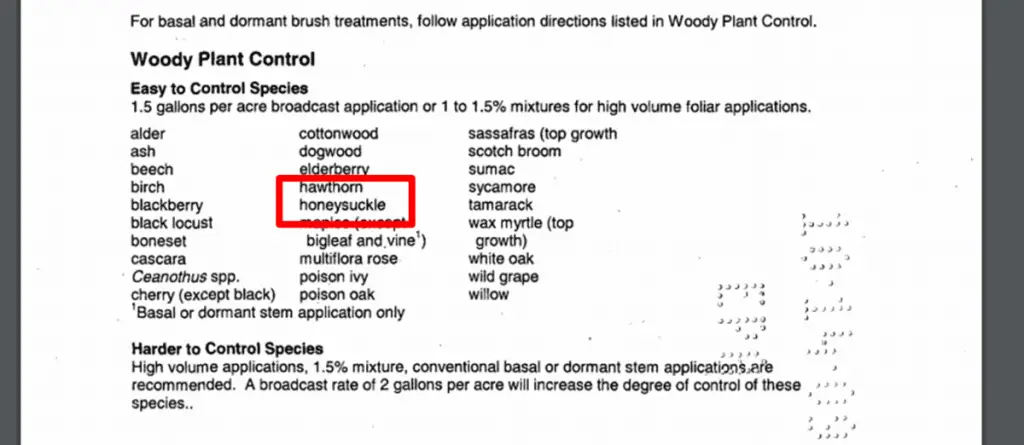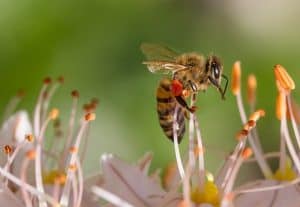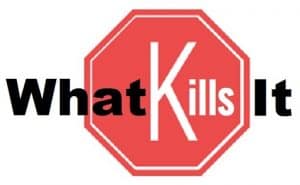They’re beautiful to look at and lovely to smell. Some people even use the beautiful flowers to decorate the tops of their summer cakes. But if you’re visiting this page, no double you’ve had enough of this invasive show stopper and you’ve got yourself an overgrown Honeysuckle plant!
You’re not alone. Unfortunately, many varieties of this sprawling beauty can get out of control in just one or two seasons. And when they do, it usually means “lights out” for surrounding plants.
Not only do overgrown Honeysuckle plants block needed sunlight, but they embed their roots in every possible place, depleting the nutrients from the soil and taking up all the space in the flower beds.
Will Crossbow Kill Honeysuckle? Yes, Crossbow, which is a readily available herbicide, can kill honeysuckle but there are some tricks of the trade and a few reasons you should never use it. Additionally, there are some steps you must take to stop regrowth after applying Crossbow.

So the short answer is Yes, you can use it on honeysuckle, but there is so much more to learn, if you’re interested. Let’s dive in…
This post may include some affiliate links to recommended products and links to other websites for your further research.
When NOT to use Crossbow to Kill Honeysuckle
If your honeysuckle is surrounded by plants and lawns you love, you should be very wary. Crossbow mist travels far and you risk killing vegetation you wanted to keep.

See the above picture of my overgrown honeysuckle?
It’s contained in a box garden. Take a closer look and you’ll notice that all the other plants are intended for human consumption. We’ve got tomato plants, lettuces, onions and a plethora of herbs.

In this case, you would never use Crossbow to kill the honeysuckle because it would contaminate the soil of your food supply and of course any overspray would likely kill your vegetable garden.
And if you’ve got honeysuckle growing near a water feature, such as coy pond or fish fountain…forget using Crossbow.
Other Considerations Before Using Crossbow on Your Honeysuckle.
Keep in mind, Crossbow is an herbicide which literally means “kills plants” and is registered with the EPA as an herbicide. Active Ingredients of any pesticide, herbicide or fungisicdes and the like, should be fully understood.
No doubt, these chemicals will be seeping into soil, which poses a threat to water, aquatic life, and food sources of humans and animals. All of the above can also pose serious health risks which is why it’s always a good idea to read the label registered with the EPA, prior to purchasing. Here is a link where you can do just that: Crossbow Label with EPA
Active Ingredient(s) in Crossbow:
2,4-dichlorophenoxyacetic acid, butoxyethyl ester ………. 34.4%
triclopyr BEE: 3,5,6-trichloro-2-pyridinyloxyacetic acid, butoxyethyl ester ………. 16.5%
Other Ingredients…………… 49.1 %
Total …………… 100.00/0

If you’re wondering about Honeybee friendliness, the first 2 active ingredients have been classified as relatively safe to the Honeybee population. Here are a couple of resource studies: link to fed study about 2 4D and link to study about triclopyr BEE
With all that out of the way, if you are ready to give Crossbow a try, here come our helpful tips.
Tips for Successfully Using Crossbow on Honeysuckle
Let’s talk about ideal conditions.
- The season: It is best to kill honeysuckle plants during growth, after flowering (late summer) or autumn.
- Wind conditions: The treatment should be done on a day with very little wind.
- Rain and humidity: There should be no rain forecasted for at least a full 24 hours.
Tips for Killing Honeysuckle with Crossbow
- Using Crossbow to kill honeysuckle: You will need, Crossbow. It is readily available at Home Depot (link to product) and even Amazon (link to product). You’ll also need the following supplies: a plastic pressure tank sprayer of at least one gallon, a pruning saw, gloves, and a mask. You may also want to prepare your drill with a wood bit (coming up).
- Wear gloves, eye protection, and a mask while using Crossbow: Before using Crossbow, put on PPE (personal protection equipment). It is also advisable to wear a mask when spraying the honeysuckle leaves. Here is a snippet from the label:
- All mixers, loaders, applicators, flaggers, and other handlers must wear: • Long-sleeved shirt and long pants • Shoes plus socks • Chemical-resistant gloves made of any waterproof material such as barrier laminate, nitrile rubber, neoprene rubber, and viton • Protective eyewear • Chemical resistant apron when mixing or loading, cleaning up spills or equipment, or otherwise exposed to the concentrate
- Mixing Crossbow to kill honeysuckle: Because everyone will use different amounts, you’ll have to read the instructions on the Crossbow bottle, mixing the correct amount of herbicide with the correct amount of water.
- Cut the honeysuckle back about 1 to 3 inches from the ground using a pruning saw or pruning shears. (Tip: If you leave enough stem above the ground, it is easier to pull out the stems and roots, later on). Some honeysuckles stems can be large and thick, but if the stems are still small you can use smaller garden shears. Remove all the leaves and branches, placing them in a tough paper bag for disposal.
- Drilling holes into the honeysuckle stem: If the honeysuckle’s stem is wider than 2 inches, take a drill and make holes by drilling in from the top, into the stem. Make as many holes as you can. If the honeysuckle stem is smaller, use a saw to make hash mark style cuts across the top of the cut stems. Once you have finished drilling the holes or making your cuts, you will spray the herbicide mixture, into the stem. This will fill the holes and gashes and seep down to the plant’s root system.
- NOTE: It is important to make your drill holes or hashmarks right after pruning. Otherwise, the trunk will dry up quickly (callous) and the wood will harden, making the drilling and cutting very difficult.
- Removing the honeysuckle: After the stem has dried out, you might notice new shoots forming from the base of the plant. The dead trunk and any new shoots should now be removed. Do not compost the these dead stems and root system.
Ways of Removing Honeysuckle Bushes without Chemicals
Although using Crossbow herbicide is a great method to remove honeysuckle, there are other ways to remove honeysuckle bushes or plants without the threat of dangerous chemicals:
· The Cut and Burn Method: Cut the honeysuckle down. Then, if it’s safe to do so, place all the cut branches and leaves in a pile, over the existing stump, and burn them. By burning the stump, it will be prevented from regrowing. At least for quite some time. However, unless you dig it out, new shoots might emerge after a couple of seasons. Address these new shoots if they are unwanted. Not all localities allow brush burning so do your due diligence and call your local officials if you are unsure of burn laws.
· The Torching Method: Torching is used in forested areas, on smaller honeysuckle plants. It has the same effect as the burning method, but is used if the foresters are afraid that the undergrowth will catch alight. The plants are cut down and removed, the stems and roots are then torched with a handheld weed torch (link to product) that fastens to a small propane tank.
· The Pulling Method: Younger honeysuckle plants can simply be pulled out by the roots. A sturdy pair of gloves may be needed as these plants are tough, and pulling the plant out can be difficult. Older honeysuckle plants require lots of digging and the job is quite the back breaker.
In Conclusion
The Honeysuckle plant can be a real showstopper in the the right garden. Unfortunately, they are not native and are an invasive species that spreads rapidly over the ground and up other trees and plants. They starve other plants of their much needed nutrients, sunlight, and water.
In natural forest areas, foresters have to battle continuously to eradicate this ‘pest’ plant, which is very hard to control. If left unchecked, other trees and native plants will die.
For best results, keep this garden gem contained in a raised bed in front of a trellis. For even better results, make sure the surrounding area of the raised bed is surrounded by rocks or concrete. This will ensure you get to enjoy the benefits of the incredible Honeysuckle and provide a feeding station for honeybees and nectar seeking birds (without it taking over).
If you need to kill honeysuckle, Crossbow is rated effective. You must follow mixing directions precisely as outlined on the container.
